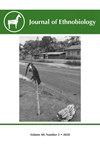Weed-fed Pigs: Food Sovereignty in the Blind Spot
IF 1.3
3区 社会学
Q1 ANTHROPOLOGY
引用次数: 0
Abstract
Implicit everyday forms of food sovereignty can be explored to reveal the diversity of the movement. For example, the ways in which elderly villagers raise pigs on weeds in central China share some features with the “quiet food sovereignty” of Russia. Small-scale pig rearing is largely invisible to outsiders, so identifying it relies heavily on weeds as indicators. Bounded by age in rural southwest Hubei, the small space of raising weed-fed pigs emerged in a blind spot between discourses on modern technological agriculture and concerns for food safety. In the 1990s, elderly villagers continued feeding pigs on local plants instead of using industrial fodder in order to retain the authentic taste of pork, which continues to have social value. The practice took on added significance as a form of self-protection from food-safety issues in the 2000s. It provides a moral buffer for elderly villagers sandwiched between the conflicting values of modern scientific and technological farming supported by the state policy of “Increasing Agricultural Prosperity with Modern Sci-tech” and emerging organic or green food movements motivated by urban people's desire for safe foods and state agenda on developing rural tourism. Despite the ecological, material, health, and social benefits of operating in this small space, their implicit food sovereignty goes unnoticed. Because raising weed-fed pigs functions invisibly, it remains in the blind spot of mass food discourses in China.杂草喂养的猪:盲点中的食物主权
可以探索隐含的日常形式的粮食主权,以揭示这场运动的多样性。例如,中国中部的老年村民在杂草上养猪的方式与俄罗斯的“安静的食物主权”有一些共同之处。小规模养猪在很大程度上是外人看不见的,因此识别它在很大程度上将依赖杂草作为指标。在鄂西南农村,由于年龄的限制,杂草养猪的狭小空间出现在现代科技农业和食品安全之间的盲点中。20世纪90年代,上了年纪的村民继续用当地的植物喂猪,而不是使用工业饲料,以保持猪肉的正宗味道,这仍然具有社会价值。在21世纪初,这种做法作为一种自我保护的形式,在食品安全问题上具有更大的意义。它为夹在“以现代科技促进农业繁荣”国家政策支持的现代科技农业价值观与新兴的有机或绿色食品运动之间的老年村民提供了道德缓冲,这些运动是由城市人民对安全食品的渴望和国家发展乡村旅游的议程推动的。尽管在这个小空间里经营有生态、物质、健康和社会效益,但他们隐含的食物主权却被忽视了。由于饲养杂草喂养的猪在无形中发挥作用,它仍然处于中国大众食品话语的盲点。
本文章由计算机程序翻译,如有差异,请以英文原文为准。
求助全文
约1分钟内获得全文
求助全文
来源期刊

Journal of Ethnobiology
Social Sciences-Anthropology
CiteScore
4.80
自引率
3.40%
发文量
21
审稿时长
>12 weeks
期刊介绍:
JoE’s readership is as wide and diverse as ethnobiology itself, with readers spanning from both the natural and social sciences. Not surprisingly, a glance at the papers published in the Journal reveals the depth and breadth of topics, extending from studies in archaeology and the origins of agriculture, to folk classification systems, to food composition, plants, birds, mammals, fungi and everything in between.
Research areas published in JoE include but are not limited to neo- and paleo-ethnobiology, zooarchaeology, ethnobotany, ethnozoology, ethnopharmacology, ethnoecology, linguistic ethnobiology, human paleoecology, and many other related fields of study within anthropology and biology, such as taxonomy, conservation biology, ethnography, political ecology, and cognitive and cultural anthropology.
JoE does not limit itself to a single perspective, approach or discipline, but seeks to represent the full spectrum and wide diversity of the field of ethnobiology, including cognitive, symbolic, linguistic, ecological, and economic aspects of human interactions with our living world. Articles that significantly advance ethnobiological theory and/or methodology are particularly welcome, as well as studies bridging across disciplines and knowledge systems. JoE does not publish uncontextualized data such as species lists; appropriate submissions must elaborate on the ethnobiological context of findings.
 求助内容:
求助内容: 应助结果提醒方式:
应助结果提醒方式:


